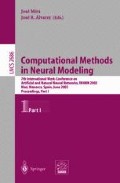Abstract
This paper proposes a concept for modeling modalities and understanding the interaction between modalities through functional brain modeling (FBM). FBM proves to be a powerful method for functional behavior prediction of a group of neuronal cells with equivalent functional behavior. An example of interacting groups of neuronal cells, utilizing FBM, in early vision is given. A broad setup of functional behavior and interaction between different groups of cells in early vision has similar conceptual properties as cells that process other sensory information or multi modal sensory information.
Access this chapter
Tax calculation will be finalised at checkout
Purchases are for personal use only
Preview
Unable to display preview. Download preview PDF.
References
D. G. Amaral and J. L. Price. Amygdalo-cortical projections in the monkey. J. Comp. Neurol., 230:465–496, 1984.
S. T. Carmichale and J. L. Price. Limbic connections of the orbital and medial prefrontal cortex in macaque monkeys. J. Comp. Neurol., 363:615–641, 1996.
J. P. Ewert, H. Buxbaum-Conradi, F. Dreisvogt, M. Glagow, C. Merkel-Harff, A. Röttingen, E. Schürg-Pfeiffer, and W. W. Schwippert. Neural modulation of visuomotor functions underlying prey-catching behaviour in anurans: perception, attention, motor performance, learning. Comparative Biochemistry and Physiology, A 128(3):417–461, 2001.
F. Heitger, L. Rosenthaler, R. von der Heydt, E. Peterhans, and O. Kübler. Simulation of neural contour mechanisms: from simple to end-stopped cells. Vision Research, 32(5):963–981, 1992.
D. Hubel and T. Wiesel. Receptive fields, binocular interaction, and functional architecture in the cat’s visual cortex. Journal of Physiology, London, 160:106–154, 1962.
D. H. Hubel. Eye, Brain, and Vision. Scientific American Library, New York, 1988.
E. R. Kandel, J. H. Schwartz, and T. M. Jessell. Principles of neural science. McGraw Hill, fourth edition, 2000.
E. Kobatake and K. Tanaka. Neuronal selectivities to complex object features in the ventral visual pathway of macaque cerebral cortex. Journal of Neurophysiology, 70:856–867, 1994.
J. E. LeDoux. Handbook of Physiology, volume 5, part 1, chapter 1, Emotion, pages 419–459. American Physiological Society, 1987.
J. E. LeDoux. The emotional brain: mysterious underpinnings of emotional life. Simon & Schuster, New York, 1996.
T. Lourens. A Biologically Plausible Model for Corner-based Object Recognition from Color Images. Shaker Publishing B.V., Maastricht, The Netherlands, March 1998.
T. Lourens, H. G. Okuno, and H. Kitano. Detection of oriented repetitive alternating patterns in color images-a computational model of monkey grating cells. In J. Mira, editor, Proceedings of the International Workshop on Artificial Neural Networks, IWANN 2001, volume 1676, Part I of Lecture Notes in Computer Science, pages 95–107, Granada, Spain, June 2001. Springer-Verlag.
J. S. Morris, A. Ohman, and R. J. Dolan. A subcortical pathway to the right amygdala mediating “unseen” fear. PNAS, 96(4):1680–1685, 1999.
E. Peterhans. Cerebral Cortex, volume 12, chapter 8, Functional Organization of Area V2 in the Awake Monkey, pages 335–357. Plenum Press, New York, 1997.
A. Pitkänen, M. Pikkarainen, N. Nurminen, and A. Ylinen. Reciprocal connections between the amygdale and the hippocampal formation, perirhinal cortex, and postrhinal cortex in rat: a review. Ann.s New York Academy of Sciences, 911:369–391, 2000.
I. A. Shevelev, N. A. Lazareva, B. V. Novikova, A. S. Tikhomirov, and G. A. Sharaev. Double orientation tuning in the cat visual cortex units. Neuroscience, 61(4):965–973, 1994.
I. A. Shevelev, R. V. Novikova, N. A. Lazareva, A. S. Tikhomirov, and G. A. Sharaev. Sensitivity to cross-like figures in the cat striate neurons. Neuroscience, 69(1):51–57, 1995.
L. R. Squire, F. E. Bloom, S. K. McConnell, J. L. Roberts, N. C. Spitzer, and M. J. Zigmond, editors. Fundamental Neuroscience. Academic Press, second edition, 2002.
R. von der Heydt, E. Peterhans, and M. R. Dürsteler. Grating cells in monkey visual cortex: Coding texture? Visual Cortex. In B. Blum, editor, Channels in the visual nervous system: neurophysiology, psychophysics and models, pages 53–73, London, 1991. Freund Publishing House Ltd.
R. von der Heydt, E. Peterhans, and M. R. Dürsteler. Periodic-Pattern-selective Cells in Monkey Visual Cortex. The Journal of Neuroscience, 12(4):1416–1434, April 1992.
R. P. Würtz and T. Lourens. Corner detection in color images through a multiscale combination of end-stopped cortical cells. Image and Vision Computing, 18(6–7):531–541, April 2000.
M. P. Young, J.W. Scannell, G. Burns, and C. Blakemore. Analysis of connectivity: neural systems in the cerebral cortex. Reviews in the Neurosciences, 5:227–250, 1994.
S. Zeki. A Vision of the Brain. Blackwell science Ltd., London, 1993.
Author information
Authors and Affiliations
Editor information
Editors and Affiliations
Rights and permissions
Copyright information
© 2003 Springer-Verlag Berlin Heidelberg
About this paper
Cite this paper
Lourens, T., Barakova, E., Tsujino, H. (2003). Interacting Modalities through Functional Brain Modeling. In: Mira, J., Álvarez, J.R. (eds) Computational Methods in Neural Modeling. IWANN 2003. Lecture Notes in Computer Science, vol 2686. Springer, Berlin, Heidelberg. https://doi.org/10.1007/3-540-44868-3_14
Download citation
DOI: https://doi.org/10.1007/3-540-44868-3_14
Published:
Publisher Name: Springer, Berlin, Heidelberg
Print ISBN: 978-3-540-40210-7
Online ISBN: 978-3-540-44868-6
eBook Packages: Springer Book Archive

